Human Resource Development Report for SHARP Organization
VerifiedAdded on 2020/07/22
|17
|5334
|111
Report
AI Summary
This report provides a comprehensive analysis of Human Resource Development (HRD) within the context of the UK-based organization SHARP. It begins by exploring various learning styles (Kolb's, Honey and Mumford's), the role of the learning curve, and the effectiveness of knowledge transfer in the workplace. The report then delves into planning and designing development and training programs, comparing the training needs of staff at different organizational levels and evaluating the advantages and disadvantages of various training methods like role play, coaching, mentoring, and job instructional techniques. A systematic approach to planning training events is outlined. The report also examines evaluation techniques and reviews the success of evaluation methods. Finally, it discusses the role of the government in HRD, the impact of the competency movement, and the influence of government training initiatives on organizational HR development.
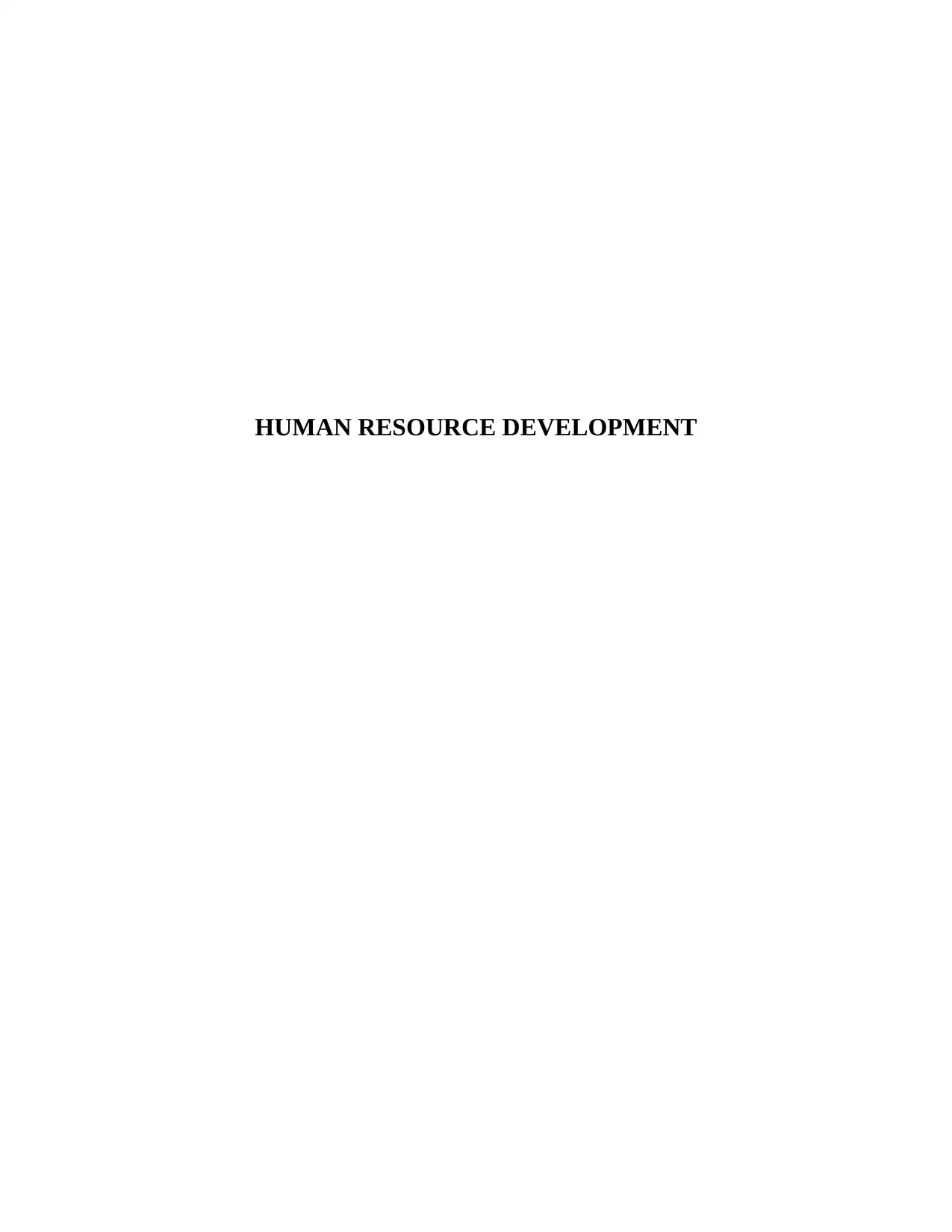
HUMAN RESOURCE DEVELOPMENT
Paraphrase This Document
Need a fresh take? Get an instant paraphrase of this document with our AI Paraphraser
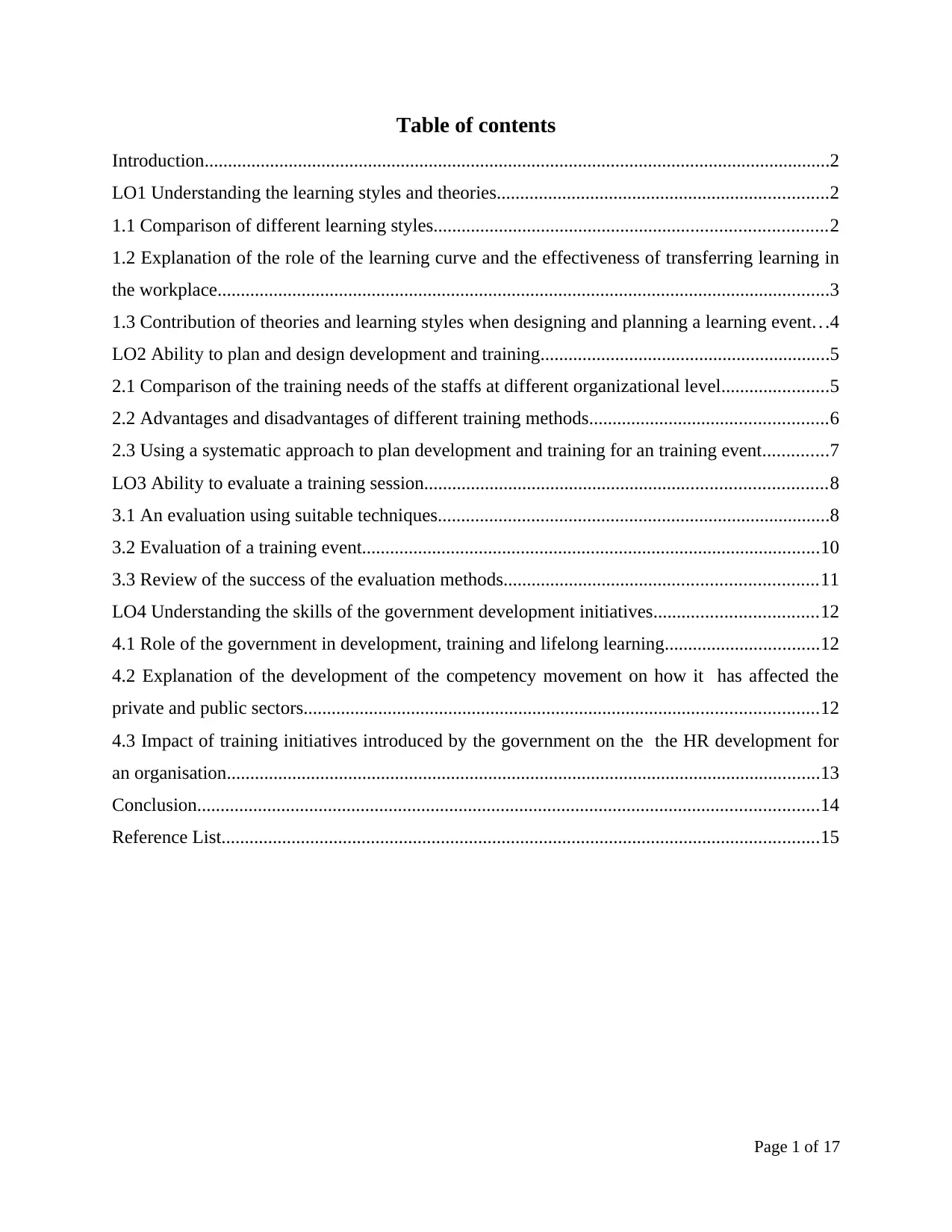
Table of contents
Introduction......................................................................................................................................2
LO1 Understanding the learning styles and theories.......................................................................2
1.1 Comparison of different learning styles....................................................................................2
1.2 Explanation of the role of the learning curve and the effectiveness of transferring learning in
the workplace...................................................................................................................................3
1.3 Contribution of theories and learning styles when designing and planning a learning event. . .4
LO2 Ability to plan and design development and training..............................................................5
2.1 Comparison of the training needs of the staffs at different organizational level.......................5
2.2 Advantages and disadvantages of different training methods...................................................6
2.3 Using a systematic approach to plan development and training for an training event..............7
LO3 Ability to evaluate a training session......................................................................................8
3.1 An evaluation using suitable techniques....................................................................................8
3.2 Evaluation of a training event..................................................................................................10
3.3 Review of the success of the evaluation methods...................................................................11
LO4 Understanding the skills of the government development initiatives...................................12
4.1 Role of the government in development, training and lifelong learning.................................12
4.2 Explanation of the development of the competency movement on how it has affected the
private and public sectors..............................................................................................................12
4.3 Impact of training initiatives introduced by the government on the the HR development for
an organisation...............................................................................................................................13
Conclusion.....................................................................................................................................14
Reference List................................................................................................................................15
Page 1 of 17
Introduction......................................................................................................................................2
LO1 Understanding the learning styles and theories.......................................................................2
1.1 Comparison of different learning styles....................................................................................2
1.2 Explanation of the role of the learning curve and the effectiveness of transferring learning in
the workplace...................................................................................................................................3
1.3 Contribution of theories and learning styles when designing and planning a learning event. . .4
LO2 Ability to plan and design development and training..............................................................5
2.1 Comparison of the training needs of the staffs at different organizational level.......................5
2.2 Advantages and disadvantages of different training methods...................................................6
2.3 Using a systematic approach to plan development and training for an training event..............7
LO3 Ability to evaluate a training session......................................................................................8
3.1 An evaluation using suitable techniques....................................................................................8
3.2 Evaluation of a training event..................................................................................................10
3.3 Review of the success of the evaluation methods...................................................................11
LO4 Understanding the skills of the government development initiatives...................................12
4.1 Role of the government in development, training and lifelong learning.................................12
4.2 Explanation of the development of the competency movement on how it has affected the
private and public sectors..............................................................................................................12
4.3 Impact of training initiatives introduced by the government on the the HR development for
an organisation...............................................................................................................................13
Conclusion.....................................................................................................................................14
Reference List................................................................................................................................15
Page 1 of 17
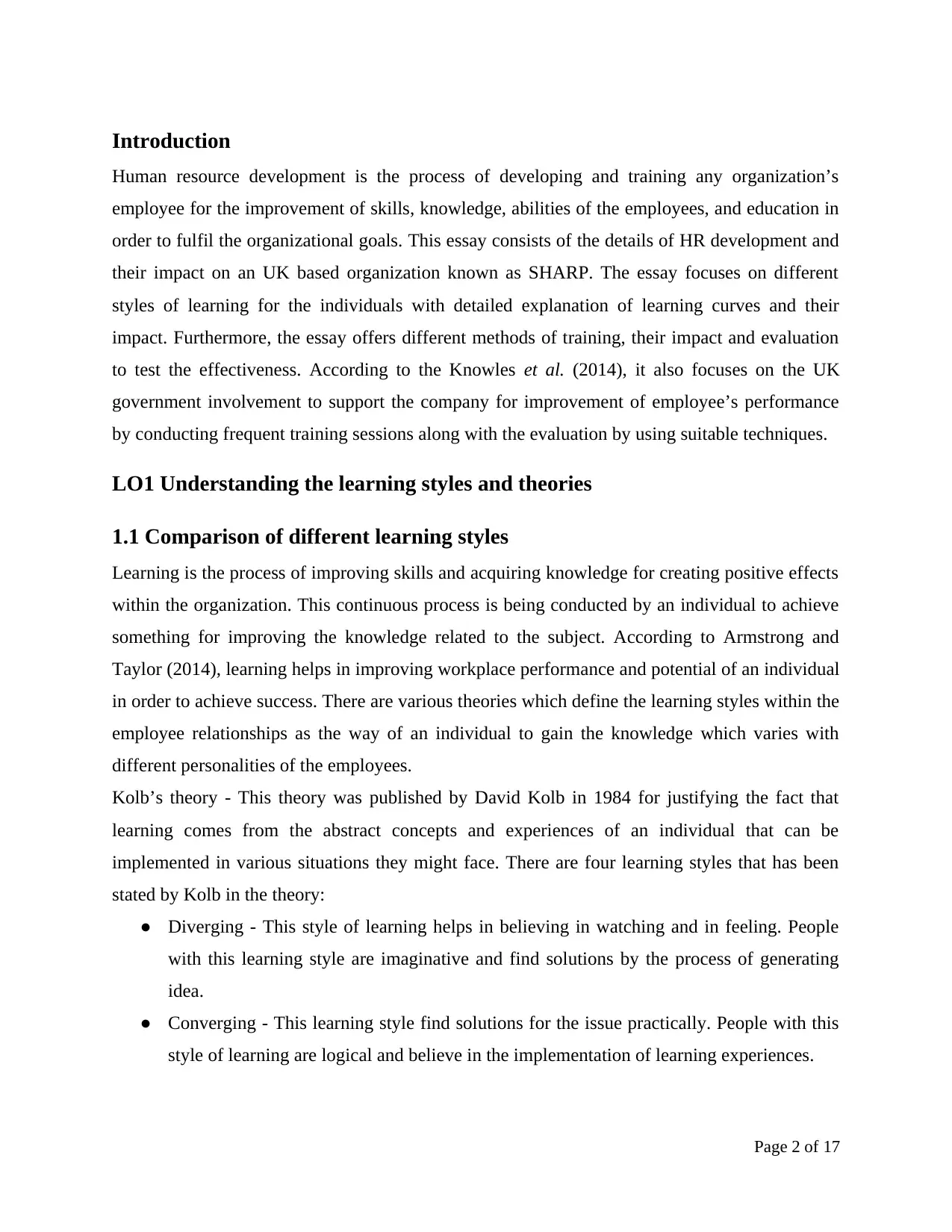
Introduction
Human resource development is the process of developing and training any organization’s
employee for the improvement of skills, knowledge, abilities of the employees, and education in
order to fulfil the organizational goals. This essay consists of the details of HR development and
their impact on an UK based organization known as SHARP. The essay focuses on different
styles of learning for the individuals with detailed explanation of learning curves and their
impact. Furthermore, the essay offers different methods of training, their impact and evaluation
to test the effectiveness. According to the Knowles et al. (2014), it also focuses on the UK
government involvement to support the company for improvement of employee’s performance
by conducting frequent training sessions along with the evaluation by using suitable techniques.
LO1 Understanding the learning styles and theories
1.1 Comparison of different learning styles
Learning is the process of improving skills and acquiring knowledge for creating positive effects
within the organization. This continuous process is being conducted by an individual to achieve
something for improving the knowledge related to the subject. According to Armstrong and
Taylor (2014), learning helps in improving workplace performance and potential of an individual
in order to achieve success. There are various theories which define the learning styles within the
employee relationships as the way of an individual to gain the knowledge which varies with
different personalities of the employees.
Kolb’s theory - This theory was published by David Kolb in 1984 for justifying the fact that
learning comes from the abstract concepts and experiences of an individual that can be
implemented in various situations they might face. There are four learning styles that has been
stated by Kolb in the theory:
● Diverging - This style of learning helps in believing in watching and in feeling. People
with this learning style are imaginative and find solutions by the process of generating
idea.
● Converging - This learning style find solutions for the issue practically. People with this
style of learning are logical and believe in the implementation of learning experiences.
Page 2 of 17
Human resource development is the process of developing and training any organization’s
employee for the improvement of skills, knowledge, abilities of the employees, and education in
order to fulfil the organizational goals. This essay consists of the details of HR development and
their impact on an UK based organization known as SHARP. The essay focuses on different
styles of learning for the individuals with detailed explanation of learning curves and their
impact. Furthermore, the essay offers different methods of training, their impact and evaluation
to test the effectiveness. According to the Knowles et al. (2014), it also focuses on the UK
government involvement to support the company for improvement of employee’s performance
by conducting frequent training sessions along with the evaluation by using suitable techniques.
LO1 Understanding the learning styles and theories
1.1 Comparison of different learning styles
Learning is the process of improving skills and acquiring knowledge for creating positive effects
within the organization. This continuous process is being conducted by an individual to achieve
something for improving the knowledge related to the subject. According to Armstrong and
Taylor (2014), learning helps in improving workplace performance and potential of an individual
in order to achieve success. There are various theories which define the learning styles within the
employee relationships as the way of an individual to gain the knowledge which varies with
different personalities of the employees.
Kolb’s theory - This theory was published by David Kolb in 1984 for justifying the fact that
learning comes from the abstract concepts and experiences of an individual that can be
implemented in various situations they might face. There are four learning styles that has been
stated by Kolb in the theory:
● Diverging - This style of learning helps in believing in watching and in feeling. People
with this learning style are imaginative and find solutions by the process of generating
idea.
● Converging - This learning style find solutions for the issue practically. People with this
style of learning are logical and believe in the implementation of learning experiences.
Page 2 of 17
⊘ This is a preview!⊘
Do you want full access?
Subscribe today to unlock all pages.

Trusted by 1+ million students worldwide
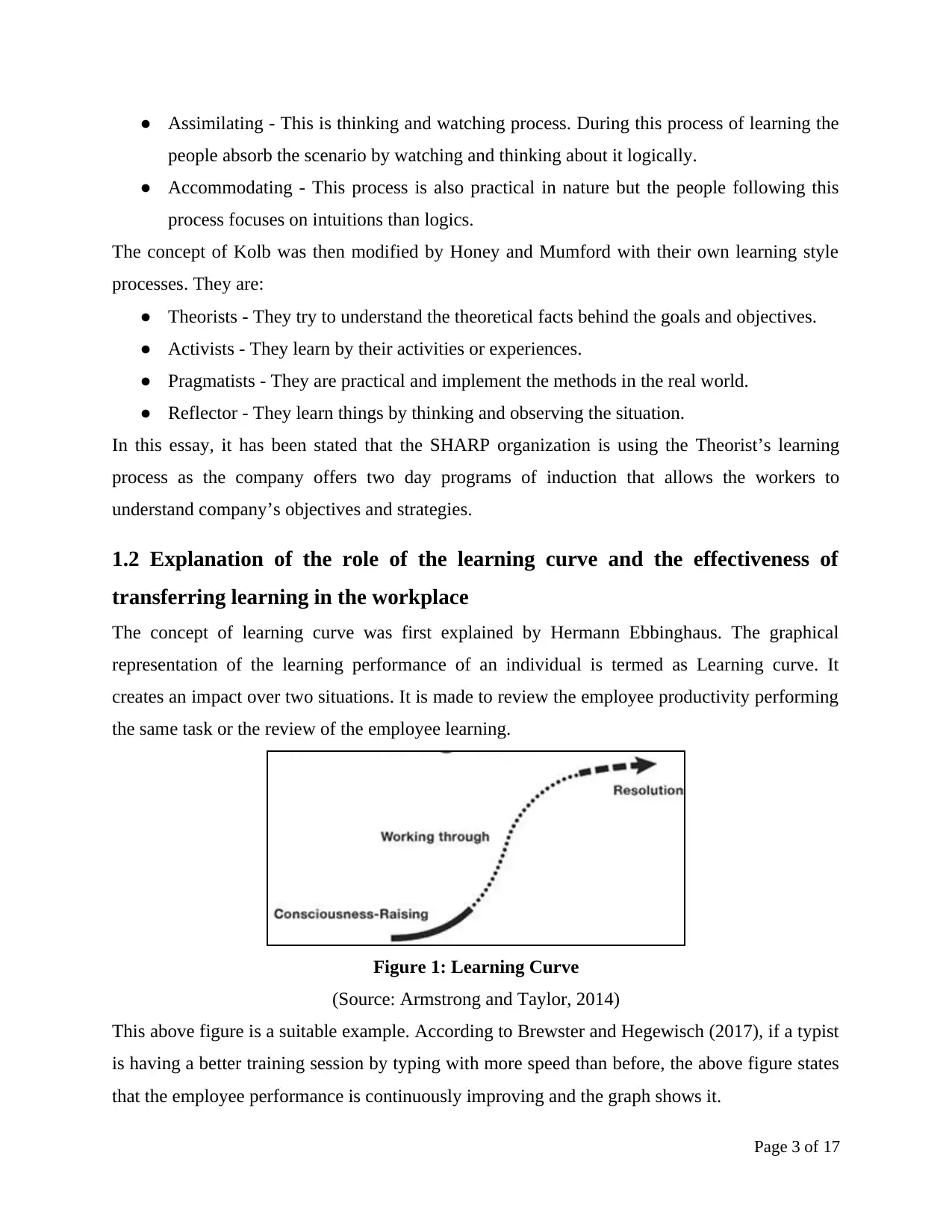
● Assimilating - This is thinking and watching process. During this process of learning the
people absorb the scenario by watching and thinking about it logically.
● Accommodating - This process is also practical in nature but the people following this
process focuses on intuitions than logics.
The concept of Kolb was then modified by Honey and Mumford with their own learning style
processes. They are:
● Theorists - They try to understand the theoretical facts behind the goals and objectives.
● Activists - They learn by their activities or experiences.
● Pragmatists - They are practical and implement the methods in the real world.
● Reflector - They learn things by thinking and observing the situation.
In this essay, it has been stated that the SHARP organization is using the Theorist’s learning
process as the company offers two day programs of induction that allows the workers to
understand company’s objectives and strategies.
1.2 Explanation of the role of the learning curve and the effectiveness of
transferring learning in the workplace
The concept of learning curve was first explained by Hermann Ebbinghaus. The graphical
representation of the learning performance of an individual is termed as Learning curve. It
creates an impact over two situations. It is made to review the employee productivity performing
the same task or the review of the employee learning.
Figure 1: Learning Curve
(Source: Armstrong and Taylor, 2014)
This above figure is a suitable example. According to Brewster and Hegewisch (2017), if a typist
is having a better training session by typing with more speed than before, the above figure states
that the employee performance is continuously improving and the graph shows it.
Page 3 of 17
people absorb the scenario by watching and thinking about it logically.
● Accommodating - This process is also practical in nature but the people following this
process focuses on intuitions than logics.
The concept of Kolb was then modified by Honey and Mumford with their own learning style
processes. They are:
● Theorists - They try to understand the theoretical facts behind the goals and objectives.
● Activists - They learn by their activities or experiences.
● Pragmatists - They are practical and implement the methods in the real world.
● Reflector - They learn things by thinking and observing the situation.
In this essay, it has been stated that the SHARP organization is using the Theorist’s learning
process as the company offers two day programs of induction that allows the workers to
understand company’s objectives and strategies.
1.2 Explanation of the role of the learning curve and the effectiveness of
transferring learning in the workplace
The concept of learning curve was first explained by Hermann Ebbinghaus. The graphical
representation of the learning performance of an individual is termed as Learning curve. It
creates an impact over two situations. It is made to review the employee productivity performing
the same task or the review of the employee learning.
Figure 1: Learning Curve
(Source: Armstrong and Taylor, 2014)
This above figure is a suitable example. According to Brewster and Hegewisch (2017), if a typist
is having a better training session by typing with more speed than before, the above figure states
that the employee performance is continuously improving and the graph shows it.
Page 3 of 17
Paraphrase This Document
Need a fresh take? Get an instant paraphrase of this document with our AI Paraphraser
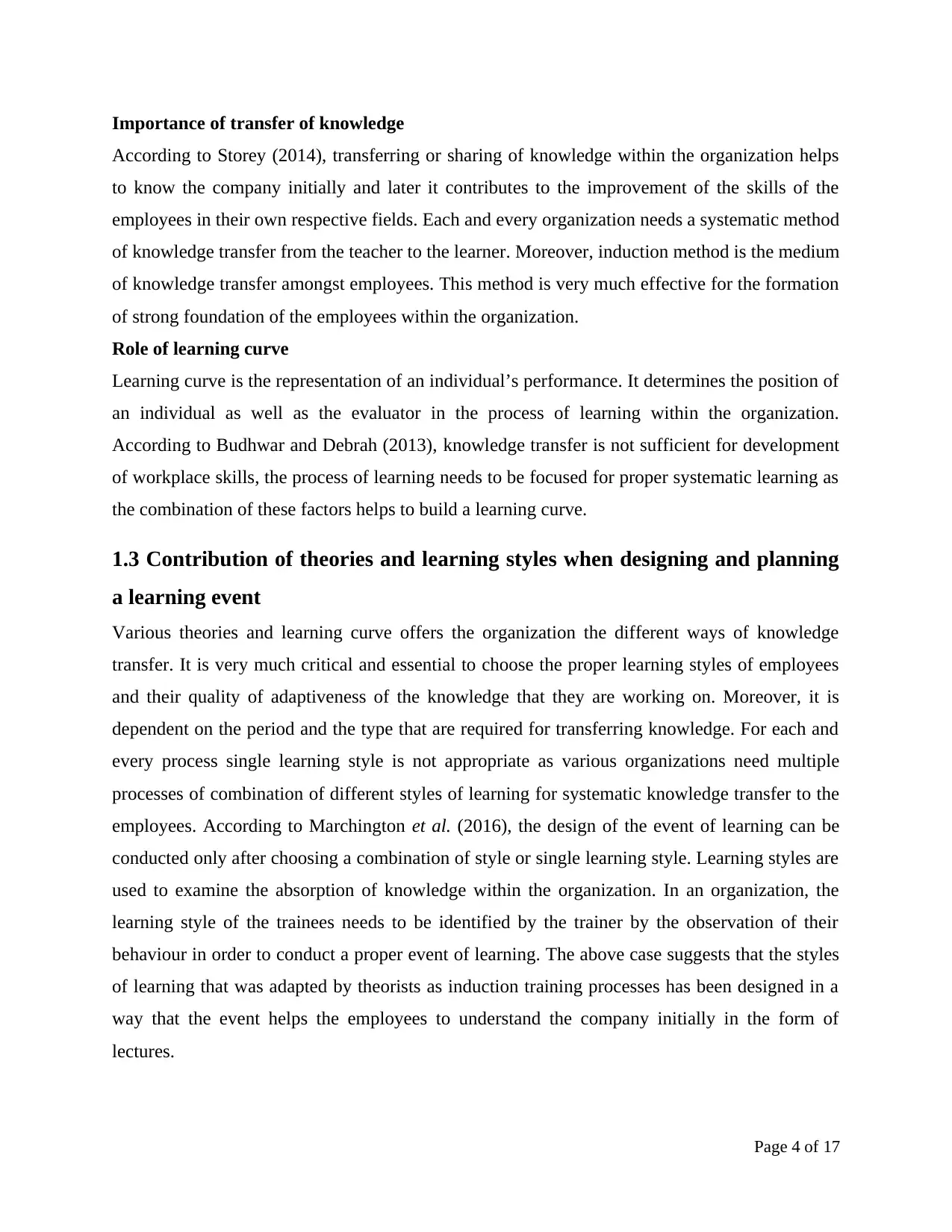
Importance of transfer of knowledge
According to Storey (2014), transferring or sharing of knowledge within the organization helps
to know the company initially and later it contributes to the improvement of the skills of the
employees in their own respective fields. Each and every organization needs a systematic method
of knowledge transfer from the teacher to the learner. Moreover, induction method is the medium
of knowledge transfer amongst employees. This method is very much effective for the formation
of strong foundation of the employees within the organization.
Role of learning curve
Learning curve is the representation of an individual’s performance. It determines the position of
an individual as well as the evaluator in the process of learning within the organization.
According to Budhwar and Debrah (2013), knowledge transfer is not sufficient for development
of workplace skills, the process of learning needs to be focused for proper systematic learning as
the combination of these factors helps to build a learning curve.
1.3 Contribution of theories and learning styles when designing and planning
a learning event
Various theories and learning curve offers the organization the different ways of knowledge
transfer. It is very much critical and essential to choose the proper learning styles of employees
and their quality of adaptiveness of the knowledge that they are working on. Moreover, it is
dependent on the period and the type that are required for transferring knowledge. For each and
every process single learning style is not appropriate as various organizations need multiple
processes of combination of different styles of learning for systematic knowledge transfer to the
employees. According to Marchington et al. (2016), the design of the event of learning can be
conducted only after choosing a combination of style or single learning style. Learning styles are
used to examine the absorption of knowledge within the organization. In an organization, the
learning style of the trainees needs to be identified by the trainer by the observation of their
behaviour in order to conduct a proper event of learning. The above case suggests that the styles
of learning that was adapted by theorists as induction training processes has been designed in a
way that the event helps the employees to understand the company initially in the form of
lectures.
Page 4 of 17
According to Storey (2014), transferring or sharing of knowledge within the organization helps
to know the company initially and later it contributes to the improvement of the skills of the
employees in their own respective fields. Each and every organization needs a systematic method
of knowledge transfer from the teacher to the learner. Moreover, induction method is the medium
of knowledge transfer amongst employees. This method is very much effective for the formation
of strong foundation of the employees within the organization.
Role of learning curve
Learning curve is the representation of an individual’s performance. It determines the position of
an individual as well as the evaluator in the process of learning within the organization.
According to Budhwar and Debrah (2013), knowledge transfer is not sufficient for development
of workplace skills, the process of learning needs to be focused for proper systematic learning as
the combination of these factors helps to build a learning curve.
1.3 Contribution of theories and learning styles when designing and planning
a learning event
Various theories and learning curve offers the organization the different ways of knowledge
transfer. It is very much critical and essential to choose the proper learning styles of employees
and their quality of adaptiveness of the knowledge that they are working on. Moreover, it is
dependent on the period and the type that are required for transferring knowledge. For each and
every process single learning style is not appropriate as various organizations need multiple
processes of combination of different styles of learning for systematic knowledge transfer to the
employees. According to Marchington et al. (2016), the design of the event of learning can be
conducted only after choosing a combination of style or single learning style. Learning styles are
used to examine the absorption of knowledge within the organization. In an organization, the
learning style of the trainees needs to be identified by the trainer by the observation of their
behaviour in order to conduct a proper event of learning. The above case suggests that the styles
of learning that was adapted by theorists as induction training processes has been designed in a
way that the event helps the employees to understand the company initially in the form of
lectures.
Page 4 of 17
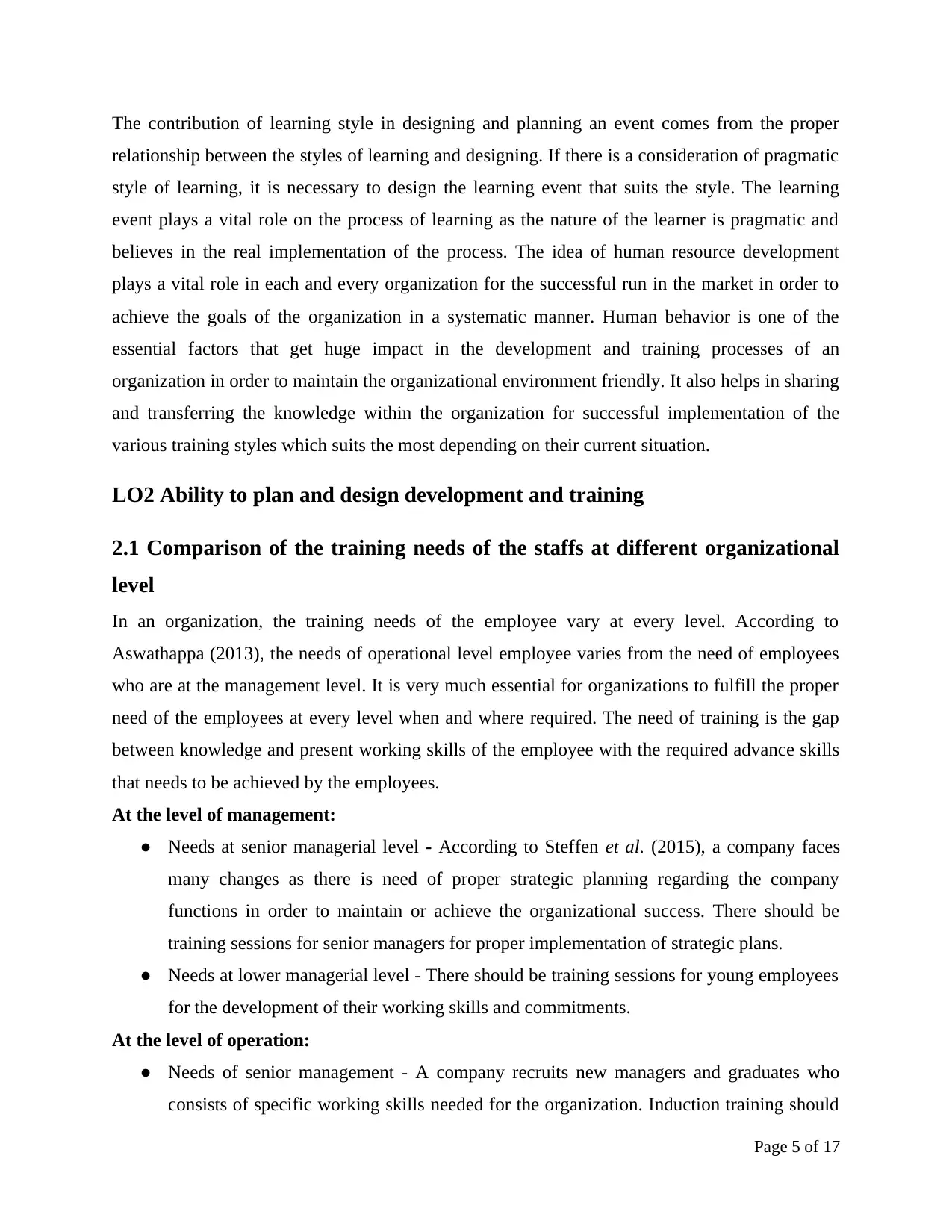
The contribution of learning style in designing and planning an event comes from the proper
relationship between the styles of learning and designing. If there is a consideration of pragmatic
style of learning, it is necessary to design the learning event that suits the style. The learning
event plays a vital role on the process of learning as the nature of the learner is pragmatic and
believes in the real implementation of the process. The idea of human resource development
plays a vital role in each and every organization for the successful run in the market in order to
achieve the goals of the organization in a systematic manner. Human behavior is one of the
essential factors that get huge impact in the development and training processes of an
organization in order to maintain the organizational environment friendly. It also helps in sharing
and transferring the knowledge within the organization for successful implementation of the
various training styles which suits the most depending on their current situation.
LO2 Ability to plan and design development and training
2.1 Comparison of the training needs of the staffs at different organizational
level
In an organization, the training needs of the employee vary at every level. According to
Aswathappa (2013), the needs of operational level employee varies from the need of employees
who are at the management level. It is very much essential for organizations to fulfill the proper
need of the employees at every level when and where required. The need of training is the gap
between knowledge and present working skills of the employee with the required advance skills
that needs to be achieved by the employees.
At the level of management:
● Needs at senior managerial level - According to Steffen et al. (2015), a company faces
many changes as there is need of proper strategic planning regarding the company
functions in order to maintain or achieve the organizational success. There should be
training sessions for senior managers for proper implementation of strategic plans.
● Needs at lower managerial level - There should be training sessions for young employees
for the development of their working skills and commitments.
At the level of operation:
● Needs of senior management - A company recruits new managers and graduates who
consists of specific working skills needed for the organization. Induction training should
Page 5 of 17
relationship between the styles of learning and designing. If there is a consideration of pragmatic
style of learning, it is necessary to design the learning event that suits the style. The learning
event plays a vital role on the process of learning as the nature of the learner is pragmatic and
believes in the real implementation of the process. The idea of human resource development
plays a vital role in each and every organization for the successful run in the market in order to
achieve the goals of the organization in a systematic manner. Human behavior is one of the
essential factors that get huge impact in the development and training processes of an
organization in order to maintain the organizational environment friendly. It also helps in sharing
and transferring the knowledge within the organization for successful implementation of the
various training styles which suits the most depending on their current situation.
LO2 Ability to plan and design development and training
2.1 Comparison of the training needs of the staffs at different organizational
level
In an organization, the training needs of the employee vary at every level. According to
Aswathappa (2013), the needs of operational level employee varies from the need of employees
who are at the management level. It is very much essential for organizations to fulfill the proper
need of the employees at every level when and where required. The need of training is the gap
between knowledge and present working skills of the employee with the required advance skills
that needs to be achieved by the employees.
At the level of management:
● Needs at senior managerial level - According to Steffen et al. (2015), a company faces
many changes as there is need of proper strategic planning regarding the company
functions in order to maintain or achieve the organizational success. There should be
training sessions for senior managers for proper implementation of strategic plans.
● Needs at lower managerial level - There should be training sessions for young employees
for the development of their working skills and commitments.
At the level of operation:
● Needs of senior management - A company recruits new managers and graduates who
consists of specific working skills needed for the organization. Induction training should
Page 5 of 17
⊘ This is a preview!⊘
Do you want full access?
Subscribe today to unlock all pages.

Trusted by 1+ million students worldwide
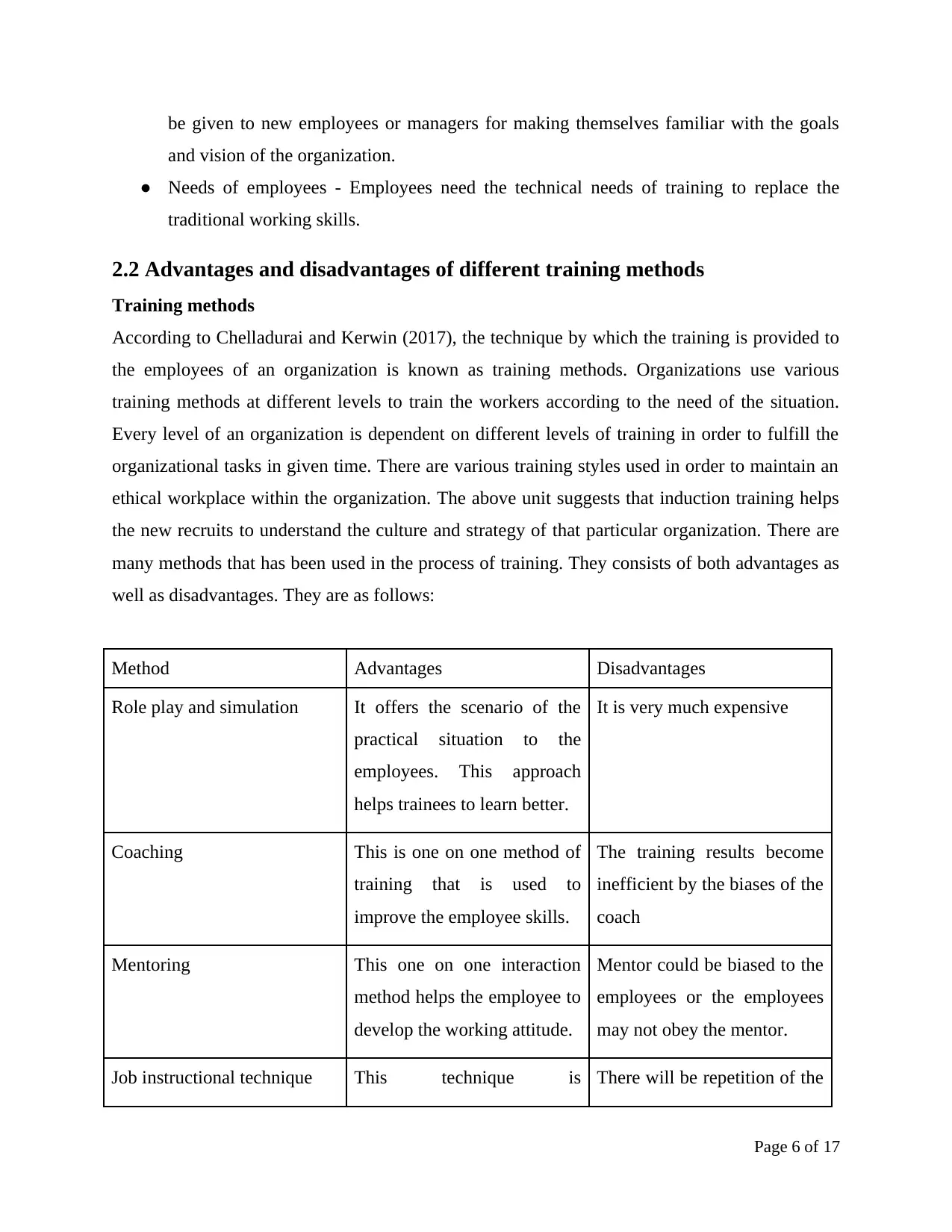
be given to new employees or managers for making themselves familiar with the goals
and vision of the organization.
● Needs of employees - Employees need the technical needs of training to replace the
traditional working skills.
2.2 Advantages and disadvantages of different training methods
Training methods
According to Chelladurai and Kerwin (2017), the technique by which the training is provided to
the employees of an organization is known as training methods. Organizations use various
training methods at different levels to train the workers according to the need of the situation.
Every level of an organization is dependent on different levels of training in order to fulfill the
organizational tasks in given time. There are various training styles used in order to maintain an
ethical workplace within the organization. The above unit suggests that induction training helps
the new recruits to understand the culture and strategy of that particular organization. There are
many methods that has been used in the process of training. They consists of both advantages as
well as disadvantages. They are as follows:
Method Advantages Disadvantages
Role play and simulation It offers the scenario of the
practical situation to the
employees. This approach
helps trainees to learn better.
It is very much expensive
Coaching This is one on one method of
training that is used to
improve the employee skills.
The training results become
inefficient by the biases of the
coach
Mentoring This one on one interaction
method helps the employee to
develop the working attitude.
Mentor could be biased to the
employees or the employees
may not obey the mentor.
Job instructional technique This technique is There will be repetition of the
Page 6 of 17
and vision of the organization.
● Needs of employees - Employees need the technical needs of training to replace the
traditional working skills.
2.2 Advantages and disadvantages of different training methods
Training methods
According to Chelladurai and Kerwin (2017), the technique by which the training is provided to
the employees of an organization is known as training methods. Organizations use various
training methods at different levels to train the workers according to the need of the situation.
Every level of an organization is dependent on different levels of training in order to fulfill the
organizational tasks in given time. There are various training styles used in order to maintain an
ethical workplace within the organization. The above unit suggests that induction training helps
the new recruits to understand the culture and strategy of that particular organization. There are
many methods that has been used in the process of training. They consists of both advantages as
well as disadvantages. They are as follows:
Method Advantages Disadvantages
Role play and simulation It offers the scenario of the
practical situation to the
employees. This approach
helps trainees to learn better.
It is very much expensive
Coaching This is one on one method of
training that is used to
improve the employee skills.
The training results become
inefficient by the biases of the
coach
Mentoring This one on one interaction
method helps the employee to
develop the working attitude.
Mentor could be biased to the
employees or the employees
may not obey the mentor.
Job instructional technique This technique is There will be repetition of the
Page 6 of 17
Paraphrase This Document
Need a fresh take? Get an instant paraphrase of this document with our AI Paraphraser
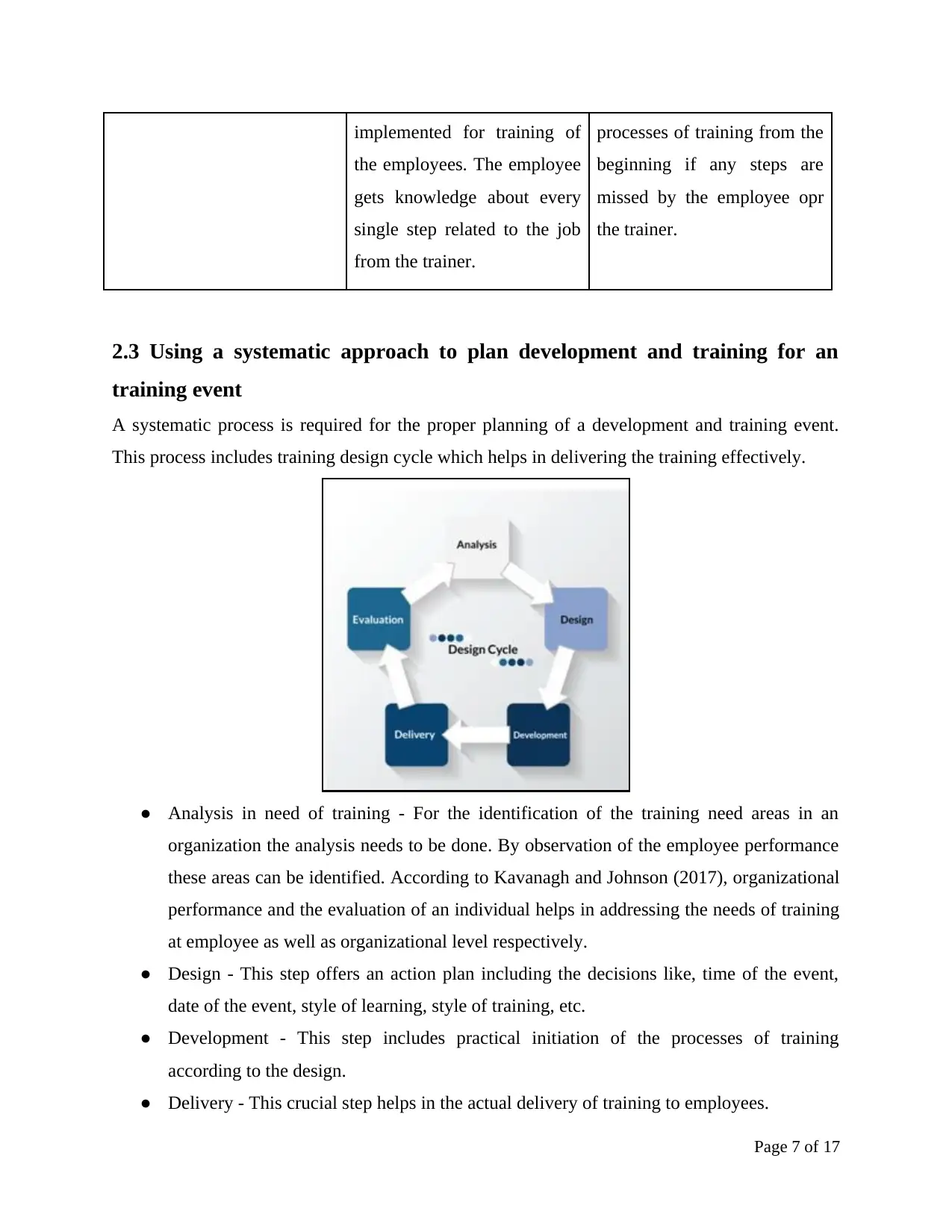
implemented for training of
the employees. The employee
gets knowledge about every
single step related to the job
from the trainer.
processes of training from the
beginning if any steps are
missed by the employee opr
the trainer.
2.3 Using a systematic approach to plan development and training for an
training event
A systematic process is required for the proper planning of a development and training event.
This process includes training design cycle which helps in delivering the training effectively.
● Analysis in need of training - For the identification of the training need areas in an
organization the analysis needs to be done. By observation of the employee performance
these areas can be identified. According to Kavanagh and Johnson (2017), organizational
performance and the evaluation of an individual helps in addressing the needs of training
at employee as well as organizational level respectively.
● Design - This step offers an action plan including the decisions like, time of the event,
date of the event, style of learning, style of training, etc.
● Development - This step includes practical initiation of the processes of training
according to the design.
● Delivery - This crucial step helps in the actual delivery of training to employees.
Page 7 of 17
the employees. The employee
gets knowledge about every
single step related to the job
from the trainer.
processes of training from the
beginning if any steps are
missed by the employee opr
the trainer.
2.3 Using a systematic approach to plan development and training for an
training event
A systematic process is required for the proper planning of a development and training event.
This process includes training design cycle which helps in delivering the training effectively.
● Analysis in need of training - For the identification of the training need areas in an
organization the analysis needs to be done. By observation of the employee performance
these areas can be identified. According to Kavanagh and Johnson (2017), organizational
performance and the evaluation of an individual helps in addressing the needs of training
at employee as well as organizational level respectively.
● Design - This step offers an action plan including the decisions like, time of the event,
date of the event, style of learning, style of training, etc.
● Development - This step includes practical initiation of the processes of training
according to the design.
● Delivery - This crucial step helps in the actual delivery of training to employees.
Page 7 of 17
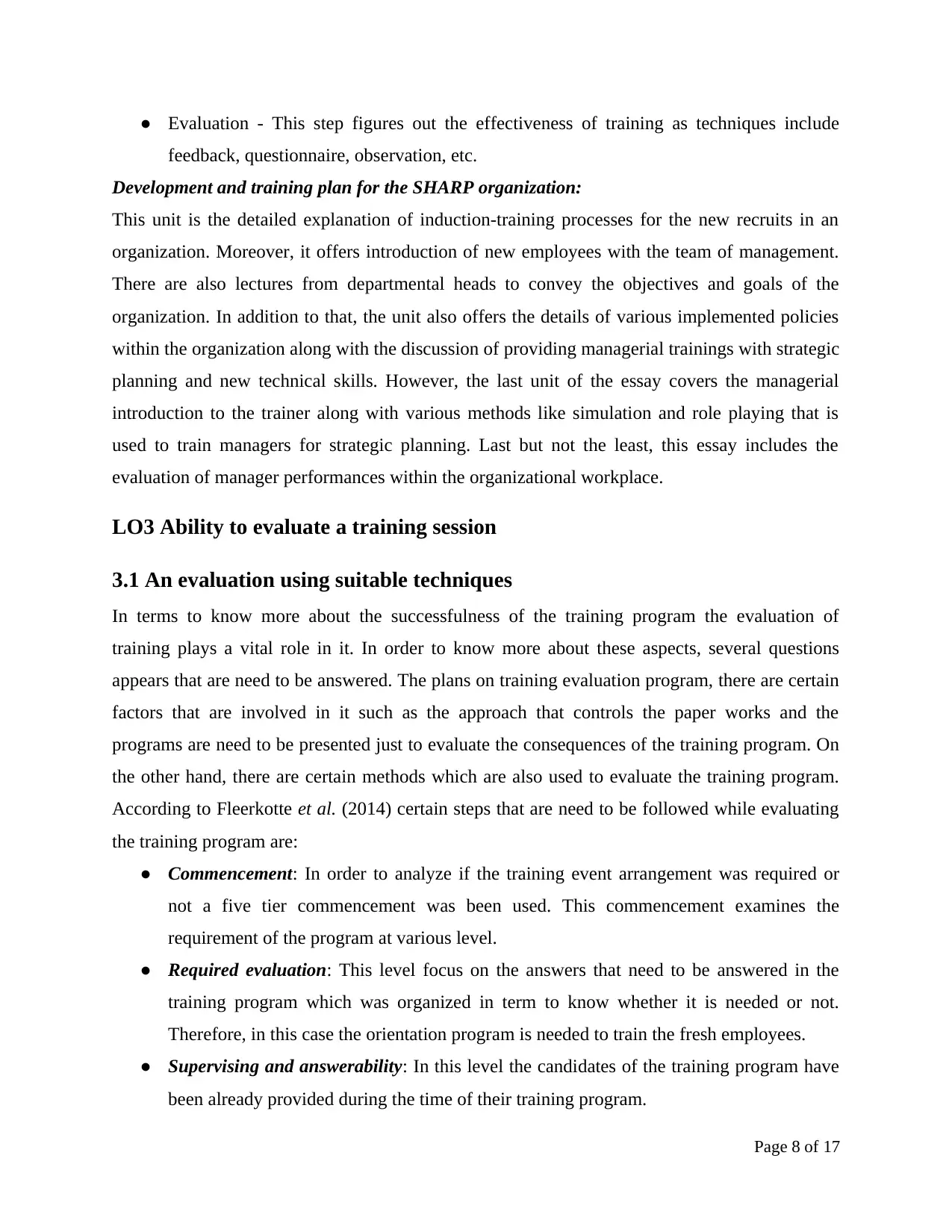
● Evaluation - This step figures out the effectiveness of training as techniques include
feedback, questionnaire, observation, etc.
Development and training plan for the SHARP organization:
This unit is the detailed explanation of induction-training processes for the new recruits in an
organization. Moreover, it offers introduction of new employees with the team of management.
There are also lectures from departmental heads to convey the objectives and goals of the
organization. In addition to that, the unit also offers the details of various implemented policies
within the organization along with the discussion of providing managerial trainings with strategic
planning and new technical skills. However, the last unit of the essay covers the managerial
introduction to the trainer along with various methods like simulation and role playing that is
used to train managers for strategic planning. Last but not the least, this essay includes the
evaluation of manager performances within the organizational workplace.
LO3 Ability to evaluate a training session
3.1 An evaluation using suitable techniques
In terms to know more about the successfulness of the training program the evaluation of
training plays a vital role in it. In order to know more about these aspects, several questions
appears that are need to be answered. The plans on training evaluation program, there are certain
factors that are involved in it such as the approach that controls the paper works and the
programs are need to be presented just to evaluate the consequences of the training program. On
the other hand, there are certain methods which are also used to evaluate the training program.
According to Fleerkotte et al. (2014) certain steps that are need to be followed while evaluating
the training program are:
● Commencement: In order to analyze if the training event arrangement was required or
not a five tier commencement was been used. This commencement examines the
requirement of the program at various level.
● Required evaluation: This level focus on the answers that need to be answered in the
training program which was organized in term to know whether it is needed or not.
Therefore, in this case the orientation program is needed to train the fresh employees.
● Supervising and answerability: In this level the candidates of the training program have
been already provided during the time of their training program.
Page 8 of 17
feedback, questionnaire, observation, etc.
Development and training plan for the SHARP organization:
This unit is the detailed explanation of induction-training processes for the new recruits in an
organization. Moreover, it offers introduction of new employees with the team of management.
There are also lectures from departmental heads to convey the objectives and goals of the
organization. In addition to that, the unit also offers the details of various implemented policies
within the organization along with the discussion of providing managerial trainings with strategic
planning and new technical skills. However, the last unit of the essay covers the managerial
introduction to the trainer along with various methods like simulation and role playing that is
used to train managers for strategic planning. Last but not the least, this essay includes the
evaluation of manager performances within the organizational workplace.
LO3 Ability to evaluate a training session
3.1 An evaluation using suitable techniques
In terms to know more about the successfulness of the training program the evaluation of
training plays a vital role in it. In order to know more about these aspects, several questions
appears that are need to be answered. The plans on training evaluation program, there are certain
factors that are involved in it such as the approach that controls the paper works and the
programs are need to be presented just to evaluate the consequences of the training program. On
the other hand, there are certain methods which are also used to evaluate the training program.
According to Fleerkotte et al. (2014) certain steps that are need to be followed while evaluating
the training program are:
● Commencement: In order to analyze if the training event arrangement was required or
not a five tier commencement was been used. This commencement examines the
requirement of the program at various level.
● Required evaluation: This level focus on the answers that need to be answered in the
training program which was organized in term to know whether it is needed or not.
Therefore, in this case the orientation program is needed to train the fresh employees.
● Supervising and answerability: In this level the candidates of the training program have
been already provided during the time of their training program.
Page 8 of 17
⊘ This is a preview!⊘
Do you want full access?
Subscribe today to unlock all pages.

Trusted by 1+ million students worldwide
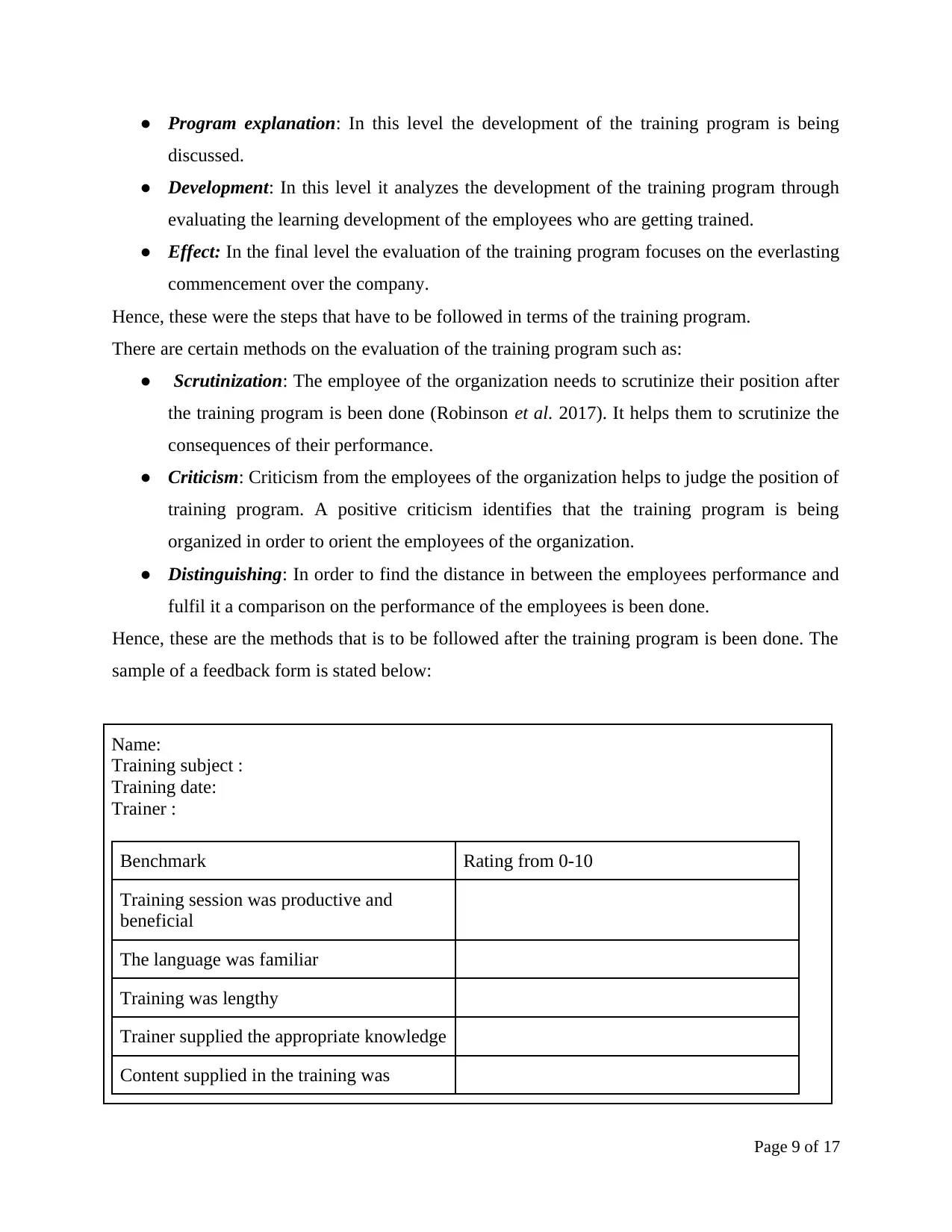
● Program explanation: In this level the development of the training program is being
discussed.
● Development: In this level it analyzes the development of the training program through
evaluating the learning development of the employees who are getting trained.
● Effect: In the final level the evaluation of the training program focuses on the everlasting
commencement over the company.
Hence, these were the steps that have to be followed in terms of the training program.
There are certain methods on the evaluation of the training program such as:
● Scrutinization: The employee of the organization needs to scrutinize their position after
the training program is been done (Robinson et al. 2017). It helps them to scrutinize the
consequences of their performance.
● Criticism: Criticism from the employees of the organization helps to judge the position of
training program. A positive criticism identifies that the training program is being
organized in order to orient the employees of the organization.
● Distinguishing: In order to find the distance in between the employees performance and
fulfil it a comparison on the performance of the employees is been done.
Hence, these are the methods that is to be followed after the training program is been done. The
sample of a feedback form is stated below:
Name:
Training subject :
Training date:
Trainer :
Benchmark Rating from 0-10
Training session was productive and
beneficial
The language was familiar
Training was lengthy
Trainer supplied the appropriate knowledge
Content supplied in the training was
Page 9 of 17
discussed.
● Development: In this level it analyzes the development of the training program through
evaluating the learning development of the employees who are getting trained.
● Effect: In the final level the evaluation of the training program focuses on the everlasting
commencement over the company.
Hence, these were the steps that have to be followed in terms of the training program.
There are certain methods on the evaluation of the training program such as:
● Scrutinization: The employee of the organization needs to scrutinize their position after
the training program is been done (Robinson et al. 2017). It helps them to scrutinize the
consequences of their performance.
● Criticism: Criticism from the employees of the organization helps to judge the position of
training program. A positive criticism identifies that the training program is being
organized in order to orient the employees of the organization.
● Distinguishing: In order to find the distance in between the employees performance and
fulfil it a comparison on the performance of the employees is been done.
Hence, these are the methods that is to be followed after the training program is been done. The
sample of a feedback form is stated below:
Name:
Training subject :
Training date:
Trainer :
Benchmark Rating from 0-10
Training session was productive and
beneficial
The language was familiar
Training was lengthy
Trainer supplied the appropriate knowledge
Content supplied in the training was
Page 9 of 17
Paraphrase This Document
Need a fresh take? Get an instant paraphrase of this document with our AI Paraphraser
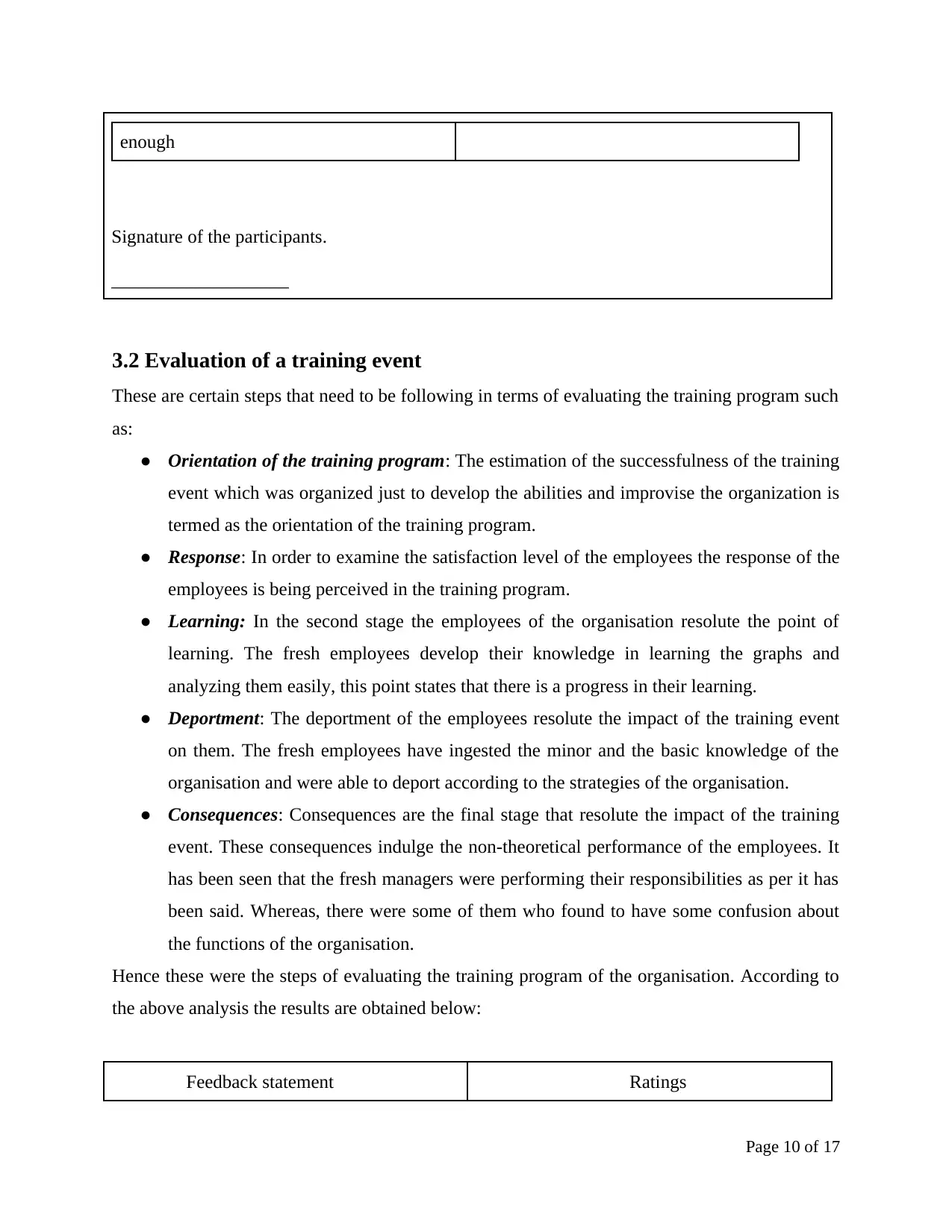
enough
Signature of the participants.
___________________
3.2 Evaluation of a training event
These are certain steps that need to be following in terms of evaluating the training program such
as:
● Orientation of the training program: The estimation of the successfulness of the training
event which was organized just to develop the abilities and improvise the organization is
termed as the orientation of the training program.
● Response: In order to examine the satisfaction level of the employees the response of the
employees is being perceived in the training program.
● Learning: In the second stage the employees of the organisation resolute the point of
learning. The fresh employees develop their knowledge in learning the graphs and
analyzing them easily, this point states that there is a progress in their learning.
● Deportment: The deportment of the employees resolute the impact of the training event
on them. The fresh employees have ingested the minor and the basic knowledge of the
organisation and were able to deport according to the strategies of the organisation.
● Consequences: Consequences are the final stage that resolute the impact of the training
event. These consequences indulge the non-theoretical performance of the employees. It
has been seen that the fresh managers were performing their responsibilities as per it has
been said. Whereas, there were some of them who found to have some confusion about
the functions of the organisation.
Hence these were the steps of evaluating the training program of the organisation. According to
the above analysis the results are obtained below:
Feedback statement Ratings
Page 10 of 17
Signature of the participants.
___________________
3.2 Evaluation of a training event
These are certain steps that need to be following in terms of evaluating the training program such
as:
● Orientation of the training program: The estimation of the successfulness of the training
event which was organized just to develop the abilities and improvise the organization is
termed as the orientation of the training program.
● Response: In order to examine the satisfaction level of the employees the response of the
employees is being perceived in the training program.
● Learning: In the second stage the employees of the organisation resolute the point of
learning. The fresh employees develop their knowledge in learning the graphs and
analyzing them easily, this point states that there is a progress in their learning.
● Deportment: The deportment of the employees resolute the impact of the training event
on them. The fresh employees have ingested the minor and the basic knowledge of the
organisation and were able to deport according to the strategies of the organisation.
● Consequences: Consequences are the final stage that resolute the impact of the training
event. These consequences indulge the non-theoretical performance of the employees. It
has been seen that the fresh managers were performing their responsibilities as per it has
been said. Whereas, there were some of them who found to have some confusion about
the functions of the organisation.
Hence these were the steps of evaluating the training program of the organisation. According to
the above analysis the results are obtained below:
Feedback statement Ratings
Page 10 of 17
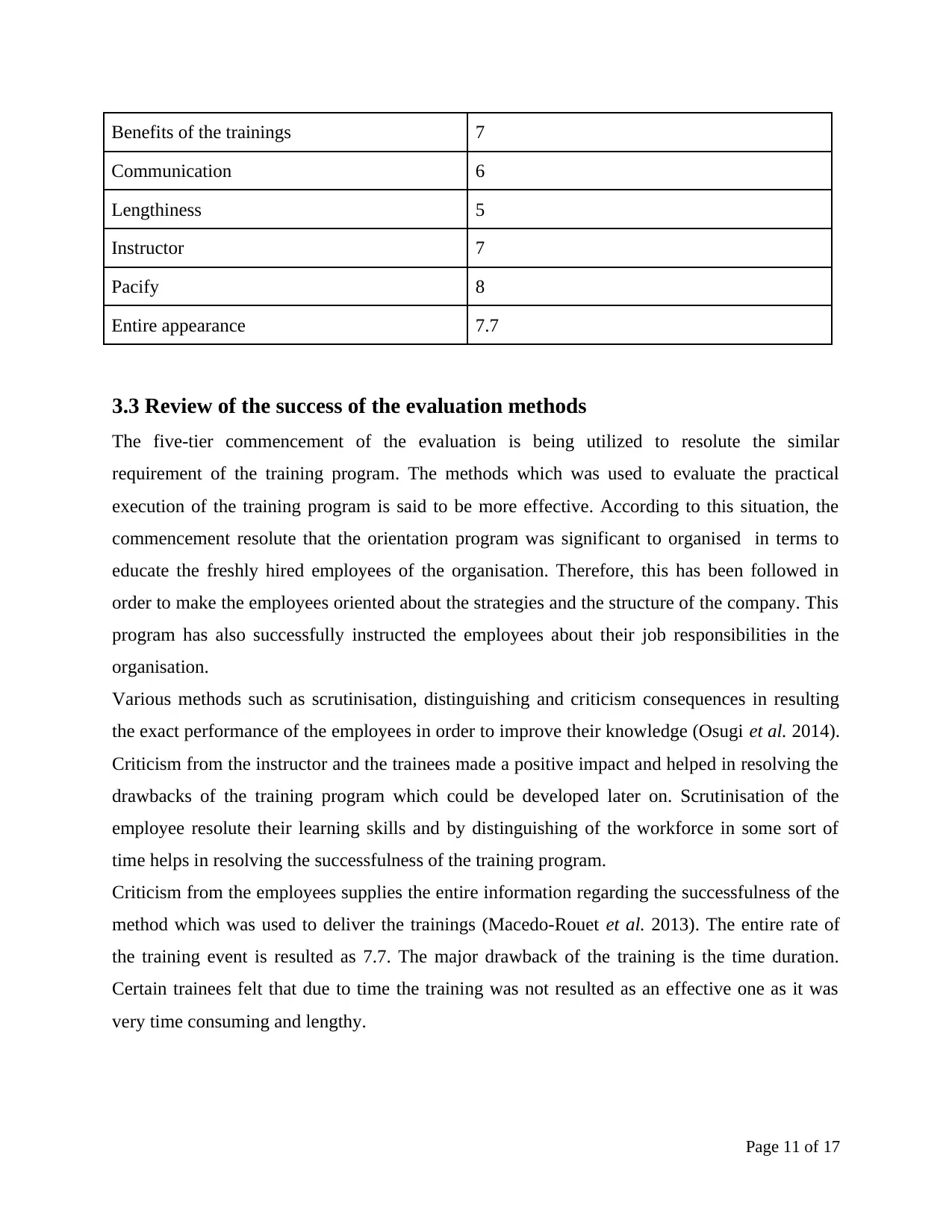
Benefits of the trainings 7
Communication 6
Lengthiness 5
Instructor 7
Pacify 8
Entire appearance 7.7
3.3 Review of the success of the evaluation methods
The five-tier commencement of the evaluation is being utilized to resolute the similar
requirement of the training program. The methods which was used to evaluate the practical
execution of the training program is said to be more effective. According to this situation, the
commencement resolute that the orientation program was significant to organised in terms to
educate the freshly hired employees of the organisation. Therefore, this has been followed in
order to make the employees oriented about the strategies and the structure of the company. This
program has also successfully instructed the employees about their job responsibilities in the
organisation.
Various methods such as scrutinisation, distinguishing and criticism consequences in resulting
the exact performance of the employees in order to improve their knowledge (Osugi et al. 2014).
Criticism from the instructor and the trainees made a positive impact and helped in resolving the
drawbacks of the training program which could be developed later on. Scrutinisation of the
employee resolute their learning skills and by distinguishing of the workforce in some sort of
time helps in resolving the successfulness of the training program.
Criticism from the employees supplies the entire information regarding the successfulness of the
method which was used to deliver the trainings (Macedo-Rouet et al. 2013). The entire rate of
the training event is resulted as 7.7. The major drawback of the training is the time duration.
Certain trainees felt that due to time the training was not resulted as an effective one as it was
very time consuming and lengthy.
Page 11 of 17
Communication 6
Lengthiness 5
Instructor 7
Pacify 8
Entire appearance 7.7
3.3 Review of the success of the evaluation methods
The five-tier commencement of the evaluation is being utilized to resolute the similar
requirement of the training program. The methods which was used to evaluate the practical
execution of the training program is said to be more effective. According to this situation, the
commencement resolute that the orientation program was significant to organised in terms to
educate the freshly hired employees of the organisation. Therefore, this has been followed in
order to make the employees oriented about the strategies and the structure of the company. This
program has also successfully instructed the employees about their job responsibilities in the
organisation.
Various methods such as scrutinisation, distinguishing and criticism consequences in resulting
the exact performance of the employees in order to improve their knowledge (Osugi et al. 2014).
Criticism from the instructor and the trainees made a positive impact and helped in resolving the
drawbacks of the training program which could be developed later on. Scrutinisation of the
employee resolute their learning skills and by distinguishing of the workforce in some sort of
time helps in resolving the successfulness of the training program.
Criticism from the employees supplies the entire information regarding the successfulness of the
method which was used to deliver the trainings (Macedo-Rouet et al. 2013). The entire rate of
the training event is resulted as 7.7. The major drawback of the training is the time duration.
Certain trainees felt that due to time the training was not resulted as an effective one as it was
very time consuming and lengthy.
Page 11 of 17
⊘ This is a preview!⊘
Do you want full access?
Subscribe today to unlock all pages.

Trusted by 1+ million students worldwide
1 out of 17
Related Documents
Your All-in-One AI-Powered Toolkit for Academic Success.
+13062052269
info@desklib.com
Available 24*7 on WhatsApp / Email
![[object Object]](/_next/static/media/star-bottom.7253800d.svg)
Unlock your academic potential
Copyright © 2020–2025 A2Z Services. All Rights Reserved. Developed and managed by ZUCOL.




